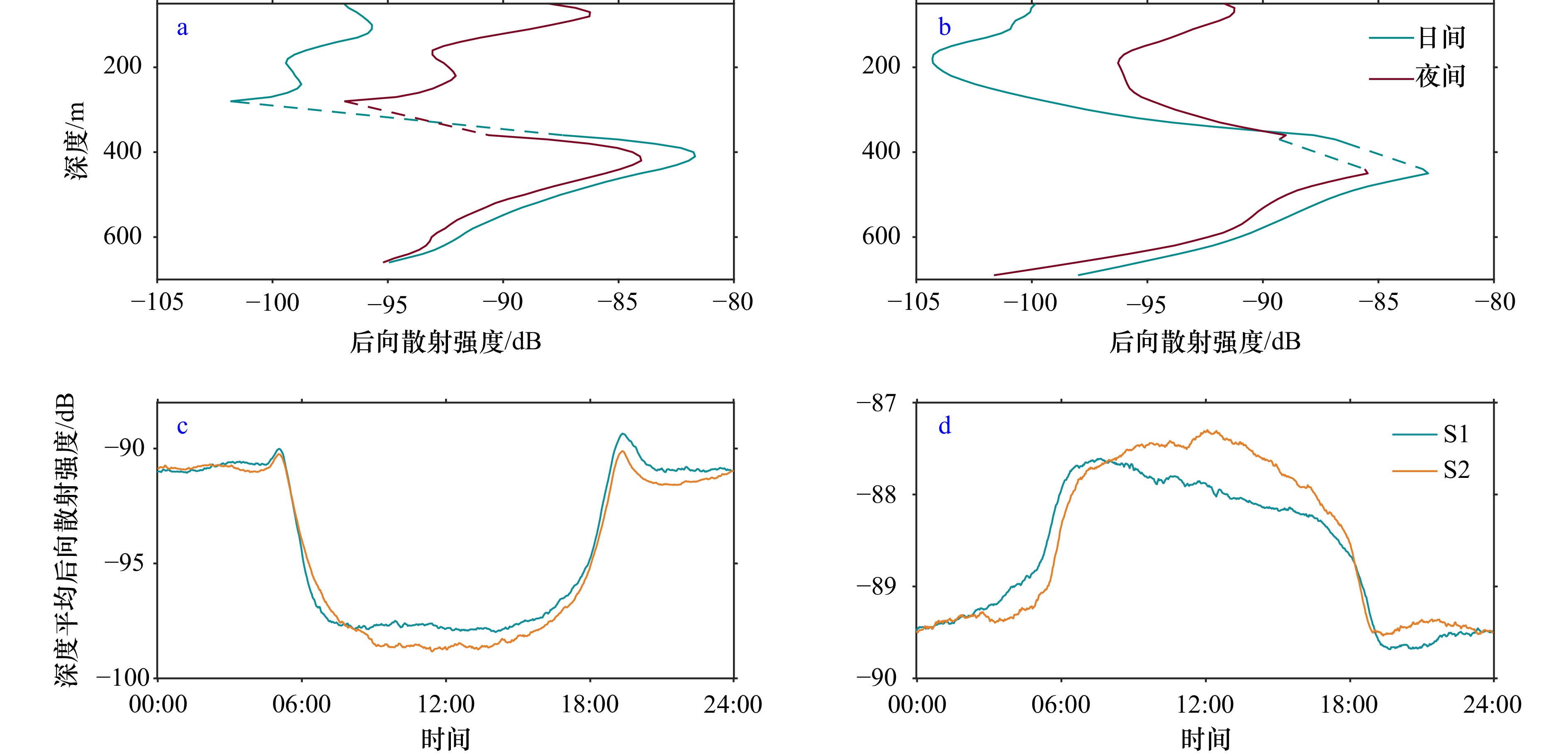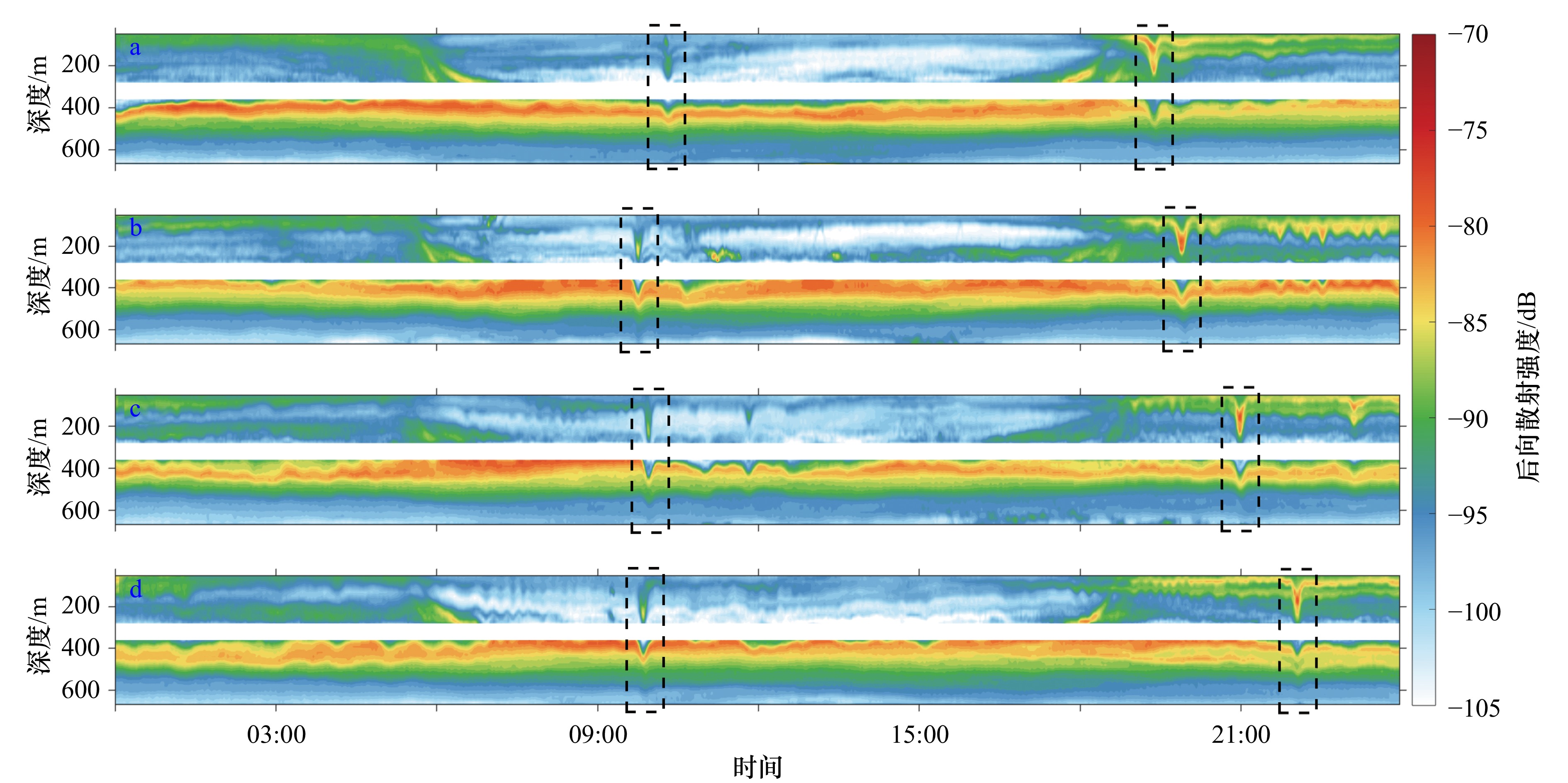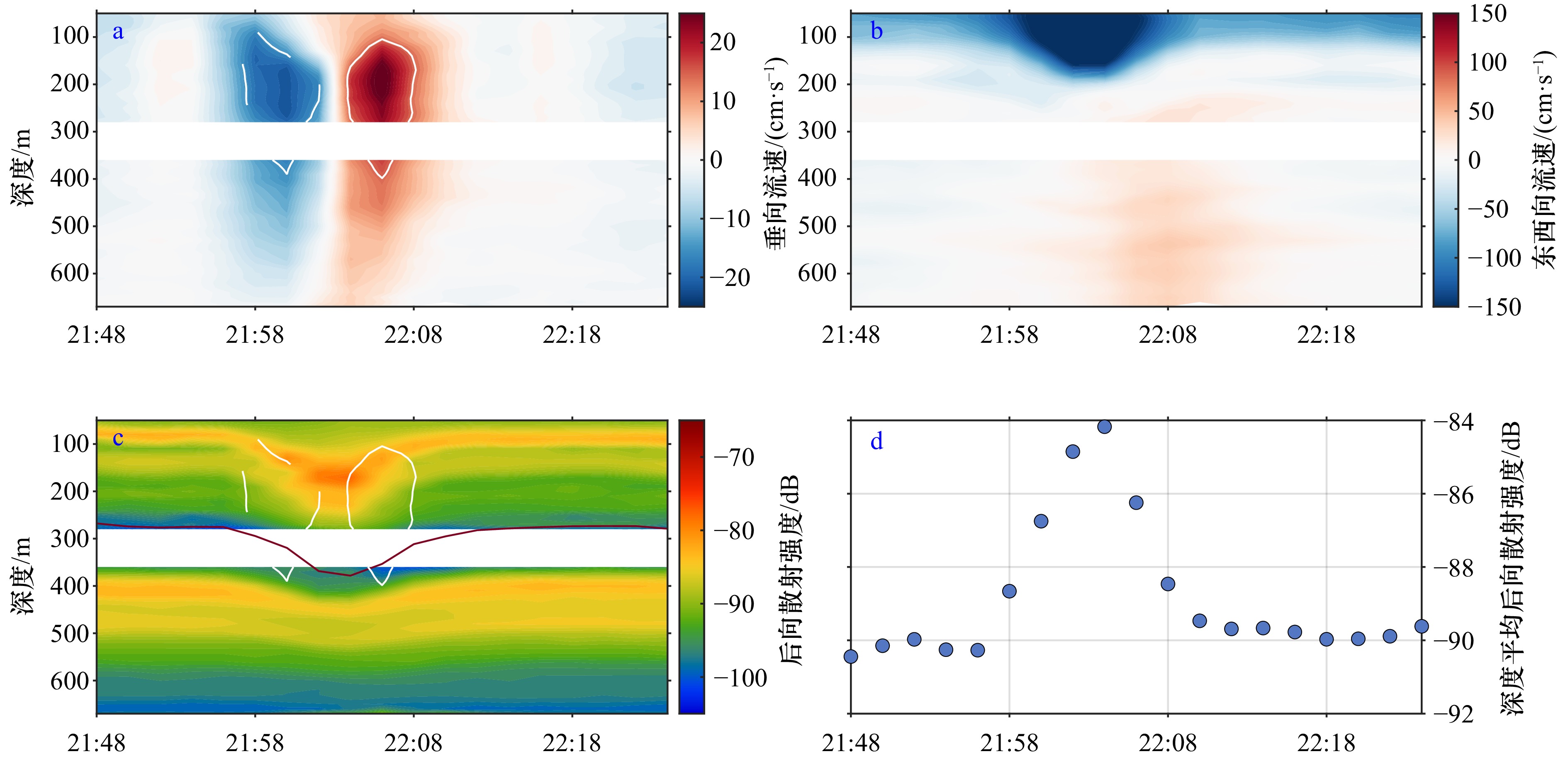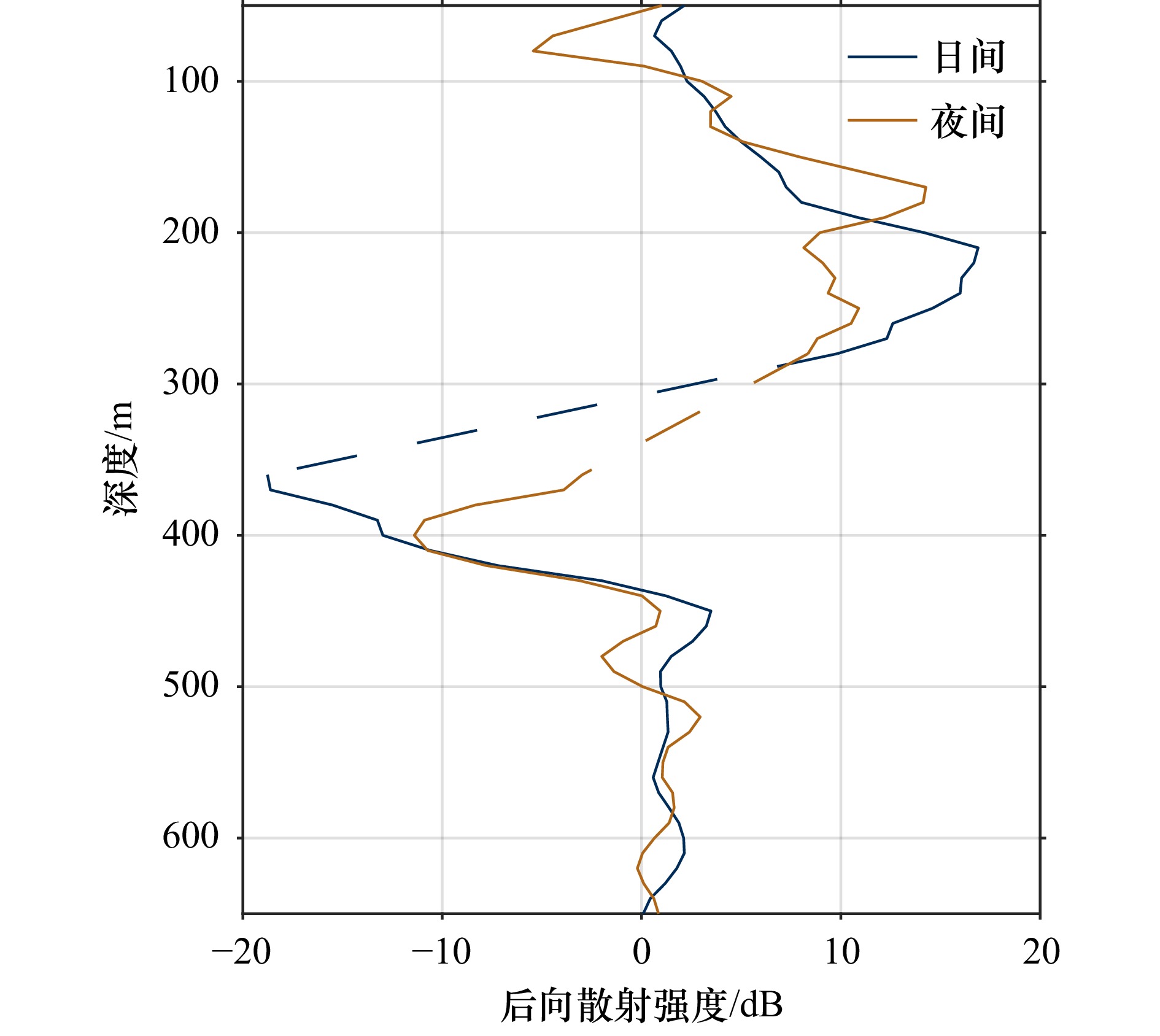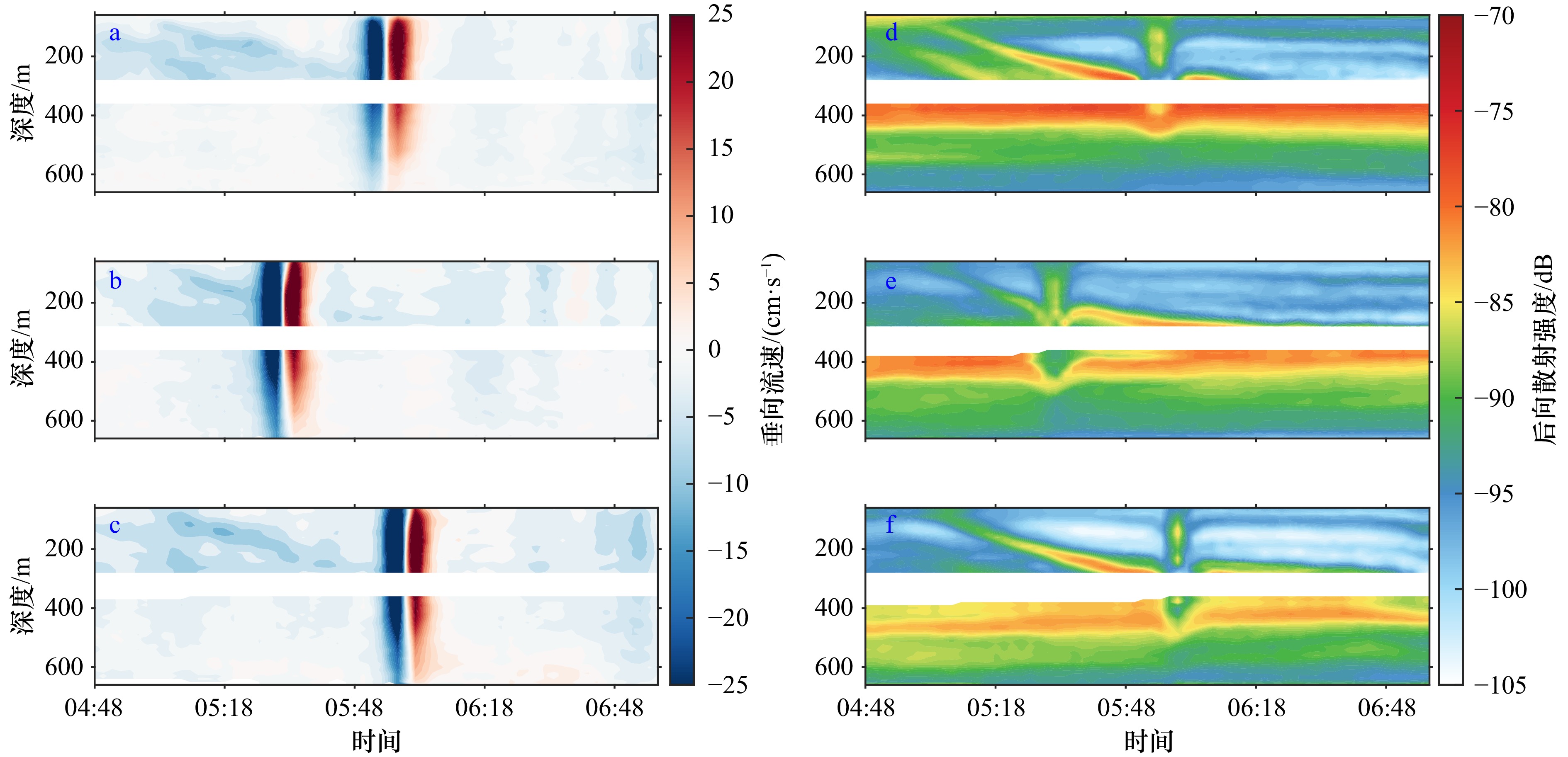Study on the vertical migration characteristics of the acoustic scattering layer under the influence of internal waves in the northern South China Sea
-
摘要: 利用深海潜标搭载的声学多普勒流速剖面仪得到的后向散射强度,研究了南海北部声散射层的昼夜垂直迁移和内孤立波对其的影响。观测结果表明:受浮游动物影响,声散射层主要表现为“昼沉夜浮”,日出前约1 h至日出期间向下移动,日落至日落后约1 h期间向上移动,平均迁移速度为4.7 cm/s(上移)和5.8 cm/s(下移)。此外,经过观测海域的内孤立波引起一对先向下后向上的垂向流,最大垂向流速超过50 cm/s,导致声散射层发生数十至上百米的起伏,海洋上层的声学后向散射强度在内孤立波波谷处达到极大值。进一步的研究显示日间出现内孤立波垂向流速与深度平均后向散射强度变化幅度相关性比夜间的内孤立波高。在两种类型波动引起的垂向流速相当时,日间的深度平均后向散射强度变化幅度通常大于夜间。
-
关键词:
- 声学多普勒流速剖面仪 /
- 内孤立波 /
- 声散射层 /
- 昼夜垂直迁移 /
- 南海
Abstract: Based on the Acoustic Doppler Current Profiler carried by deep-sea moorings, we investigated the diel vertical migration of the acoustic scattering layer and the impact of internal solitary waves on it in the northern South China Sea. The observational results reveal that the acoustic scattering layer, influenced by zooplankton, ascends to shallower depth within approximately an hour after sunset, remains there throughout the night, then migrates to the deeper depth within about an hour before sunrise. The average migration velocities are 4.7 cm/s (upward) and 5.8 cm/s (downward). Additionally, internal solitary waves observed in the region induce a pair of downward and upward currents, with maximum vertical velocities exceeding 50 cm/s, leading to fluctuations of tens to hundreds of meters in the acoustic scattering layer. The acoustic backscattering strength of the ocean’s upper layer reaches its maximum value at the troughs of internal solitary waves. Further research indicates that the daytime internal solitary waves exhibit a stronger correlation between the vertical velocity and the depth-averaged backscattering strength variation compared to the nighttime internal solitary waves. When the vertical velocities induced by both types of waves are equal, the depth-averaged backscattering strength variations during the day are typically greater than those at night. -
图 2 观测期间的平均昼夜垂直迁移模式
a. S1站位后向散射强度,b. S2站位后向散射强度,c. S1站位垂向流速,d. S2站位垂向流速。空白区域为两台ADCP的盲区,蓝色(红色)虚线代表观测期间的平均日出(日落)时刻
Fig. 2 The average diel vertical migration patterns during the observation period
a. MVBS of Station S1, b. MVBS of Station S2, c. vertical velocities of Stations S1, d. vertical velocities of Stations S2. The blank areas represent the blank distance of the two ADCPs. The blue (red) dashed lines indicate the average sunrise (sunset) times during the observation period
图 4 S1站位昼夜平均后向散射强度剖面(a),S2站位昼夜平均后向散射强度剖面(b)(虚线部分为ADCP盲区);海洋上层50~270 m深度平均后向散射强度(c),海洋下层450~650 m深度平均后向散射强度(d)
Fig. 4 Daytime and nighttime average MVBS profiles at Station S1 (a); daytime and nighttime average MVBS profiles at Station S2 (b) (the dashed sections represent the blank distance of two ADCPs); depth-averaged MVBS of the ocean’s upper layer from 50 m to 270 m depth (c); depth-averaged MVBS of the ocean’s lower layer from 450 m to 650 m depth (d)
图 5 S1站位垂向流速在4月1日(a)、4月2日(b)、4月3日(c)、4月4日(d)的分布和东西向流速在4月1日(e)、4月2日(f)、4月3日(g)、4月4日(h)的分布(虚线框内标示了内孤立波)
Fig. 5 Vertical velocities of Station S1 on April 1 (a), April 2 (b), April 3 (c), and April 4 (d), and the east-west velocities on April 1 (e), April 2 (f), April 3 (g), and April 4 (h) (dashed boxes mark the presence of internal solitary waves)
图 7 S1站位4月4日日间的内孤立波垂向流速(a),东西向流速(b),后向散射强度(c),海洋上层(50~270 m)的深度平均后向散射强度(d)
空白区域为两台ADCP的盲区,棕色线表示13℃等温线,白色实线(虚线)为垂向流速15 cm/s(−15 cm/s)等值线
Fig. 7 Internal solitary waves at Station S1 during daytime on April 4 vertical velocity (a), east-west velocityv (b), MVBS (c), depth-averaged MVBS of the ocean’s upper layer (50 m to 270 m) (d)
Blank areas indicate the blank distance of the two ADCPs. The brown line represents the 13°C isotherm. The white solid line (dashed line) represents contour lines of vertical velocity at 15 cm/s (−15 cm/s)
图 8 S1站位4月4日夜间的内孤立波垂向流速(a),东西向流速(b),后向散射强度(c),海洋上层(50~270 m)的深度平均后向散射强度(d)
空白区域为两台ADCP的盲区,棕色线表示13℃等温线,白色实线(虚线)为垂向流速15 cm/s(−15 cm/s)等值线
Fig. 8 Internal solitary waves at Station S1 during nighttime on April 4 vertical velocity (a), east-west velocity (b), MVBS (c), depth-averaged MVBS of the ocean’s upper layer (50 m to 270 m) (d)
Blank areas indicate the blank distance of the two ADCPs. The brown line represents the 13°C isotherm. The white solid line (dashed line) represents contour lines of vertical velocity at 15 cm/s (−15 cm/s)
图 9 4月4日内孤立波期间后向散射强度变化幅度深度剖面
蓝色为日间的内孤立波,黄色为夜间的内孤立波,虚线部分为ADCP盲区
Fig. 9 Depth profile of MVBS variation during internalsolitary waves on April 4
Blue indicates daytime internal solitary waves and yellow indicatesnighttime internal solitary waves. The dashed sections representthe blank distance of two ADCPs
图 10 内孤立波导致的深度平均后向散射强度变化幅度与最大垂向流速的关系
绿色点为日间出现的内孤立波,红色点为夜间出现的内孤立波
Fig. 10 Relationship between the depth-averaged MVBS variation induced by internal solitary waves andthe maximum vertical velocity
Green dots represent internal solitary waves occurring during the daytime, while red dots represent those occurring during the nighttime
-
[1] Tont S A. Deep scattering layers: patterns in the Pacific[J]. California Cooperative Oceanic Fisheries Investigations, 1976, 18: 112−117. [2] Steinberg D K, Carlson C A, Bates N R, et al. Zooplankton vertical migration and the active transport of dissolved organic and inorganic carbon in the Sargasso Sea[J]. Deep Sea Research Part I: Oceanographic Research Papers, 2000, 47(1): 137−158. doi: 10.1016/S0967-0637(99)00052-7 [3] Al-Mutairi H, Landry M R. Active export of carbon and nitrogen at Station ALOHA by diel migrant zooplankton[J]. Deep Sea Research Part II: Topical Studies in Oceanography, 2001, 48(8/9): 2083−2103. [4] Hays G C. A review of the adaptive significance and ecosystem consequences of zooplankton diel vertical migrations[J]. Hydrobiologia, 2003, 503(1): 163−170. [5] Ianson D, Jackson G A, Angel M V, et al. Effect of net avoidance on estimates of diel vertical migration[J]. Limnology and Oceanography, 2004, 49(6): 2297−2303. doi: 10.4319/lo.2004.49.6.2297 [6] Huntley M E, Zhou Meng. Influence of animals on turbulence in the sea[J]. Marine Ecology Progress Series, 2004, 273: 65−79. doi: 10.3354/meps273065 [7] Dewar W K, Bingham R J, Iverson R L, et al. Does the marine biosphere mix the ocean?[J]. Journal of Marine Research, 2006, 64(4): 541−561. doi: 10.1357/002224006778715720 [8] Katija K. Biogenic inputs to ocean mixing[J]. Journal of Experimental Biology, 2012, 215(6): 1040−1049. doi: 10.1242/jeb.059279 [9] Dean C W. Biophysical interactions in the straits of Florida: turbulent mixing due to diel vertical migrations of zooplankton[D]. Fort Lauderdale: Nova Southeastern University, 2014. [10] Lü Liangang, Liu Jianjun, Yu Fei, et al. Vertical migration of sound scatterers in the southern Yellow Sea in summer[J]. Ocean Science Journal, 2007, 42(1): 1−8. doi: 10.1007/BF03020905 [11] 陈钊, 吕连港, 杨光兵, 等. 基于船载ADCP和LADCP观测的南海声散射层[J]. 海洋科学进展, 2016, 34(2): 240−249. doi: 10.3969/j.issn.1671-6647.2016.02.009Chen Zhao, Lü Liangang, Yang Guangbing, et al. Research on sound scattering layer in the South China Sea observed with ship-board ADCP and LADCP[J]. Advances in Marine Science, 2016, 34(2): 240−249. doi: 10.3969/j.issn.1671-6647.2016.02.009 [12] 王雨微, 黄二辉, 许德伟. 海洋生物声散射层研究现状综述[J]. 海洋开发与管理, 2021, 38(9): 43−48. doi: 10.3969/j.issn.1005-9857.2021.09.007Wang Yuwei, Huang Erhui, Xu Dewei. International research advances in marine biological acoustic scattering layer[J]. Ocean Development and Management, 2021, 38(9): 43−48. doi: 10.3969/j.issn.1005-9857.2021.09.007 [13] Postel L, da Silva A J, Mohrholz V, et al. Zooplankton biomass variability off Angola and Namibia investigated by a lowered ADCP and net sampling[J]. Journal of Marine Systems, 2007, 68(1/2): 143−166. [14] Kaartvedt S, Staby A, Aksnes D L. Efficient trawl avoidance by mesopelagic fishes causes large underestimation of their biomass[J]. Marine Ecology Progress Series, 2012, 456: 1−6. doi: 10.3354/meps09785 [15] Davison P, Lara-Lopez A, Koslow J A. Mesopelagic fish biomass in the southern California current ecosystem[J]. Deep Sea Research Part II: Topical Studies in Oceanography, 2015, 112: 129−142. doi: 10.1016/j.dsr2.2014.10.007 [16] Zhou Meng, Dorland R D. Aggregation and vertical migration behavior of Euphausiasuperba[J]. Deep Sea Research Part II: Topical Studies in Oceanography, 2004, 51(17/19): 2119−2137. [17] Radenac M H, Plimpton P E, Lebourges-Dhaussy A, et al. Impact of environmental forcing on the acoustic backscattering strength in the equatorial Pacific: diurnal, lunar, intraseasonal, and interannual variability[J]. Deep Sea Research Part I: Oceanographic Research Papers, 2010, 57(10): 1314−1328. doi: 10.1016/j.dsr.2010.06.004 [18] Menkès C E, Allain V, Rodier M, et al. Seasonal oceanography from physics to micronekton in the South-West Pacific[J]. Deep Sea Research Part II: Topical Studies in Oceanography, 2015, 113: 125−144. doi: 10.1016/j.dsr2.2014.10.026 [19] Smeti H, Pagano M, Menkes C, et al. Spatial and temporal variability of zooplankton off New Caledonia (southwestern Pacific) from acoustics and net measurements[J]. Journal of Geophysical Research: Oceans, 2015, 120(4): 2676−2700. doi: 10.1002/2014JC010441 [20] Jiang Songnian, Dickey T D, Steinberg D K, et al. Temporal variability of zooplankton biomass from ADCP backscatter time series data at the Bermuda Testbed Mooring site[J]. Deep Sea Research Part I: Oceanographic Research Papers, 2007, 54(4): 608−636. doi: 10.1016/j.dsr.2006.12.011 [21] Haney J F. Diel patterns of zooplankton behavior[J]. Bulletin of Marine Science, 1988, 43(3): 583−603. [22] Heywood K J, Scrope-Howe S, Barton E D. Estimation of zooplankton abundance from shipborne ADCP backscatter[J]. Deep Sea Research Part A. Oceanographic Research Papers, 1991, 38(6): 677−691. doi: 10.1016/0198-0149(91)90006-2 [23] Cohen J H, Forward Jr R B. Spectral sensitivity of vertically migrating marine copepods[J]. The Biological Bulletin, 2002, 203(3): 307−314. doi: 10.2307/1543573 [24] Zhou Meng, Huntley M E. The principle of biological attraction, demonstrated by the bio-continuum theory of zooplankton patch dynamics[J]. Journal of Marine Research, 1996, 54(5): 1017−1037. doi: 10.1357/0022240963213619 [25] Lü Liangang, Wang Xiao, Wang Huiwu, et al. The variations of zooplankton biomass and their migration associated with the Yellow Sea Warm Current[J]. Continental Shelf Research, 2013, 64: 10−19. doi: 10.1016/j.csr.2013.05.007 [26] Wang Zhankun, DiMarco S F, Ingle S, et al. Seasonal and annual variability of vertically migrating scattering layers in the northern Arabian Sea[J]. Deep Sea Research Part I: Oceanographic Research Papers, 2014, 90: 152−165. doi: 10.1016/j.dsr.2014.05.008 [27] Inoue R, Kitamura M, Fujiki T. Diel vertical migration of zooplankton at the S1 biogeochemical mooring revealed from acoustic backscattering strength[J]. Journal of Geophysical Research: Oceans, 2016, 121(2): 1031−1050. doi: 10.1002/2015JC011352 [28] Sandstrom H, Elliot J A, Cchrane N A. Observing groups of solitary internal waves and turbulence with BATFISH and echo-sounder[J]. Journal of Physical Oceanography, 1989, 19(7): 987−997. doi: 10.1175/1520-0485(1989)019<0987:OGOSIW>2.0.CO;2 [29] Hebert D, Moum J N, Paulson C A, et al. Turbulence and internal waves at the equator. Part II: details of a single event[J]. Journal of Physical Oceanography, 1992, 22(11): 1346−1356. doi: 10.1175/1520-0485(1992)022<1346:TAIWAT>2.0.CO;2 [30] Wallace B C, Wilkinson D L. Run-up of internal waves on a gentle slope in a two-layered system[J]. Journal of Fluid Mechanics, 1988, 191: 419−442. doi: 10.1017/S0022112088001636 [31] Sangrá P, Basterretxea G, Pelegrí J L, et al. Chlorophyll increase due to internal waves on the shelf break of Gran Canaria (Canary Islands)[J]. Scientia Marina, 2001, 65(S1): 89−97. doi: 10.3989/scimar.2001.65s189 [32] Greer A T, Cowen R K, Guigand C M, et al. The role of internal waves in larval fish interactions with potential predators and prey[J]. Progress in Oceanography, 2014, 127: 47−61. doi: 10.1016/j.pocean.2014.05.010 [33] Yang Chenghao, Liao Guanghong, Yuan Yaochu, et al. The diel vertical migration of sound scatterers observed by an acoustic Doppler current profiler in the Luzon Strait from July 2009 to April 2011[J]. Acta Oceanologica Sinica, 2013, 32(11): 1−9. [34] 刘世刚, 汤勇, 陈国宝, 等. 南海深海声学散射层垂直分布和昼夜变化初步研究[J]. 海洋科学进展, 2015, 33(2): 173−181. doi: 10.3969/j.issn.1671-6647.2015.02.005Liu Shigang, Tang Yong, Chen Guobao, et al. Vertical distribution and diurnal movement of the deep scattering layer in the South China Sea[J]. Advances in Marine Science, 2015, 33(2): 173−181. doi: 10.3969/j.issn.1671-6647.2015.02.005 [35] 王东旭. 南海中部深海散射层声学特性及时空分布研究[D]. 大连: 大连海洋大学, 2017.Wang Dongxu. Acoustic characteristics and Spatio-temporal distribution of deep scattering layer in the central South China Sea[D]. Dalian: Dalian Ocean University, 2017. [36] 陈钊. 南海声散射层和涡旋对其影响的研究[D]. 青岛: 国家海洋局第一海洋研究所, 2016.Chen Zhao. Study on the sound scattering layer in the South China Sea and the influence of eddies[D]. Qingdao: First Institute of Oceanography, State Oceanic Administration, 2016. [37] 李琦, 陈朝晖. 基于ADCP回声的黑潮−亲潮混合区浮游动物昼夜垂直迁移研究[J]. 海洋与湖沼, 2022, 53(2): 305−319. doi: 10.11693/hyhz20211000250Li Qi, Chen Zhaohui. Diel vertial migration of zooplankton in the Kuroshio-Oyashio mixed zone based on ADCP echo[J]. Oceanologia et Limnologia Sinica, 2022, 53(2): 305−319. doi: 10.11693/hyhz20211000250 [38] Wang Bei, Yu Fei, Wang Ran, et al. Intraseasonal variability of the deep scattering layer induced by mesoscale eddy[J]. Frontiers in Marine Science, 2024, 11: 1367410. doi: 10.3389/fmars.2024.1367410 [39] Yang Chenghao, Xu Dongfeng, Chen Zuozhi, et al. Diel vertical migration of zooplankton and micronekton on the northern slope of the South China Sea observed by a moored ADCP[J]. Deep Sea Research Part II: Topical Studies in Oceanography, 2019, 167: 93−104. doi: 10.1016/j.dsr2.2019.04.012 [40] 刘明东, 杨光兵, 熊学军, 等. 天文大潮对南海北部浮游动物生物量的影响[J]. 海洋科学进展, 2023, 41(1): 123−134. doi: 10.12362/j.issn.1671-6647.20211220001Liu Mingdong, Yang Guangbing, Xiong Xuejun, et al. Effect of astronomical tide on the zooplankton biomass in the northern South China Sea[J]. Advances in Marine Science, 2023, 41(1): 123−134. doi: 10.12362/j.issn.1671-6647.20211220001 [41] Cai Shuqun, Xie Jieshuo, He Jianling. An overview of internal solitary waves in the South China Sea[J]. Surveys in Geophysics, 2012, 33(5): 927−943. doi: 10.1007/s10712-012-9176-0 [42] Tian Jiwei, Zhou Lei, Zhang Xiaoqian. Latitudinal distribution of mixing rate caused by the M2 internal tide[J]. Journal of Physical Oceanography, 2006, 36(1): 35−42. doi: 10.1175/JPO2824.1 [43] Liu A K, Chang Y S, Hsu M K, et al. Evolution of nonlinear internal waves in the East and South China Seas[J]. Journal of Geophysical Research: Oceans, 1998, 103(C4): 7995−8008. doi: 10.1029/97JC01918 [44] 蔡树群, 何建玲, 谢皆烁. 近10年来南海孤立内波的研究进展[J]. 地球科学进展, 2011, 26(7): 703−710.Cai Shuqun, He Jianling, Xie Jieshuo. Recent decadal progress of the study on internal solitonsin the South China Sea[J]. Advances in Earth Science, 2011, 26(7): 703−710. [45] Holligan P M, Pingree R D, Mardell G T. Oceanic solitons, nutrient pulses and phytoplankton growth[J]. Nature, 1985, 314(6009): 348−350. doi: 10.1038/314348a0 [46] Pan Xiaoju, Wong G T F, Shiah F K, et al. Enhancement of biological productivity by internal waves: observations in the summertime in the northern South China Sea[J]. Journal of Oceanography, 2012, 68(3): 427−437. doi: 10.1007/s10872-012-0107-y [47] Guan Zhenyu, Ge Ruping, Li Yunxia, et al. Diel variation of phytoplankton communities in the northern South China Sea under the effect of internal solitary waves and its response to environmental factors[J]. Water, 2023, 15(13): 2422. doi: 10.3390/w15132422 [48] Lennert-Cody C E, Franks P J S. Plankton patchiness in high-frequency internal waves[J]. Marine Ecology Progress Series, 1999, 186: 59−66. doi: 10.3354/meps186059 [49] Ramp S R, Tang T Y, Duda T F, et al. Internal solitons in the northeastern South China Sea. Part I: Sources and deep water propagation[J]. IEEE Journal of Oceanic Engineering, 2004, 29(4): 1157−1181. doi: 10.1109/JOE.2004.840839 [50] 黄晓冬. 南海内孤立波的空间分布与时间变化特征研究[D]. 青岛: 中国海洋大学, 2013.Huang Xiaodong. Study on the spatial distributions and temporal variations of internal solitary waves in the South China Sea[D]. Qingdao: Ocean University of China, 2013. [51] Gordon R L. Acoustic Doppler current profiler Principles of operation: a practical primer[M]. San Diego, California USA by RD Instruments, January 8, 1996, 7. [52] Deines K L. Backscatter estimation using broadband acoustic Doppler current profilers[C]//Proceedings of the IEEE Sixth Working Conference on Current Measurement (Cat. No. 99CH36331). San Diego, CA, USA: IEEE, 1999: 249−253. [53] Mullison J. Backscatter estimation using broadband acoustic Doppler current profilers-updated[C]//Proceedings of the ASCE Hydraulic Measurements & Experimental Methods Conference. Durham, NH, USA, 2017: 9−12. [54] Potiris E, Frangoulis C, Kalampokis A, et al. Acoustic Doppler current profiler observations of migration patterns of zooplankton in the Cretan Sea[J]. Ocean Science, 2018, 14(4): 783−800. doi: 10.5194/os-14-783-2018 [55] 袁叔尧, 邓九仔. 南海北部内孤立波数学模型[J]. 热带海洋, 1999, 18(3): 16−23.Yuan Shuyao, Deng Jiuzi. Mathematical model of internal solitary waves in northern South China Sea[J]. Tropic Oceanology, 1999, 18(3): 16−23. [56] 徐亚军, 赵亮, 原野. 基于声学仪器与粒径分析仪研究东海浮游动物昼夜垂直迁移过程[J]. 海洋学报, 2016, 38(8): 123−130. doi: 10.3969/j.issn.0253-4193.2016.08.013Xu Yajun, Zhao Liang, Yuan Ye. The diel vertical migration of zooplankton observed by an acoustic Doppler current profiler and particle size analyzer in the East China Sea[J]. Haiyang Xuebao, 2016, 38(8): 123−130. doi: 10.3969/j.issn.0253-4193.2016.08.013 [57] Luo Jiangang, Ortner P B, Forcucci D, et al. Diel vertical migration of zooplankton and mesopelagic fish in the Arabian Sea[J]. Deep Sea Research Part II: Topical Studies in Oceanography, 2000, 47(7/8): 1451−1473. [58] Ariza A, Landeira J M, Escánez A, et al. Vertical distribution, composition and migratory patterns of acoustic scattering layers in the Canary Islands[J]. Journal of Marine Systems, 2016, 157: 82−91. doi: 10.1016/j.jmarsys.2016.01.004 [59] Kaneko A, Zhu Xiaohua, Radenac M H. Dirunal variability and its quantification of subsurface sound scatterers in the western equatorial Pacific[J]. Journal of Oceanography, 1996, 52(5): 655−674. doi: 10.1007/BF02238326 [60] Cisewski B, Strass V H, Rhein M, et al. Seasonal variation of diel vertical migration of zooplankton from ADCP backscatter time series data in the Lazarev Sea, Antarctica[J]. Deep Sea Research Part I: Oceanographic Research Papers, 2010, 57(1): 78−94. doi: 10.1016/j.dsr.2009.10.005 [61] Liu Yanliang, Guo Jingsong, Xue Yuhuan, et al. Seasonal variation in diel vertical migration of zooplankton and micronekton in the Andaman Sea observed by a moored ADCP[J]. Deep Sea Research Part I: Oceanographic Research Papers, 2022, 179: 103663. doi: 10.1016/j.dsr.2021.103663 [62] Haury L R, Briscoe M G, Orr M H. Tidally generated internal wave packets in Massachusetts Bay[J]. Nature, 1979, 278(5702): 312−317. doi: 10.1038/278312a0 [63] Lennert-Cody C E, Franks P J S. Fluorescence patches in high-frequency internal waves[J]. Marine Ecology Progress Series, 2002, 235: 29−42. doi: 10.3354/meps235029 [64] Haury L R, Wiebe P H, Orr M H, et al. Tidally generated high-frequency internal wave packets and their effects on plankton in Massachusetts Bay[J]. Journal of Marine Research, 1983, 41(1): 65−112. doi: 10.1357/002224083788223036 [65] Hsu M K, Liu A K. Nonlinear internal waves in the South China Sea[C]//Proceedings of the Ninth (1999) International Offshore and Polar Engineering Conference. Brest, France: ISOPE, 1999: ISOPE-I-99-253. [66] Cheriton O M, McManus M A, Stacey M T, et al. Physical and biological controls on the maintenance and dissipation of a thin phytoplankton layer[J]. Marine Ecology Progress Series, 2009, 378: 55−69. doi: 10.3354/meps07847 [67] Haney J C. Ocean internal waves as sources of small-scale patchiness in seabird distribution on the Blake Plateau[J]. The Auk, 1987, 104(1): 129−133. doi: 10.2307/4087244 [68] Silber G K, Smultea M A. Harbor porpoises utilize tidally-induced internal waves[J]. Bulletin Southern California Academy of Sciences, 1990, 89(3): 139−142. -




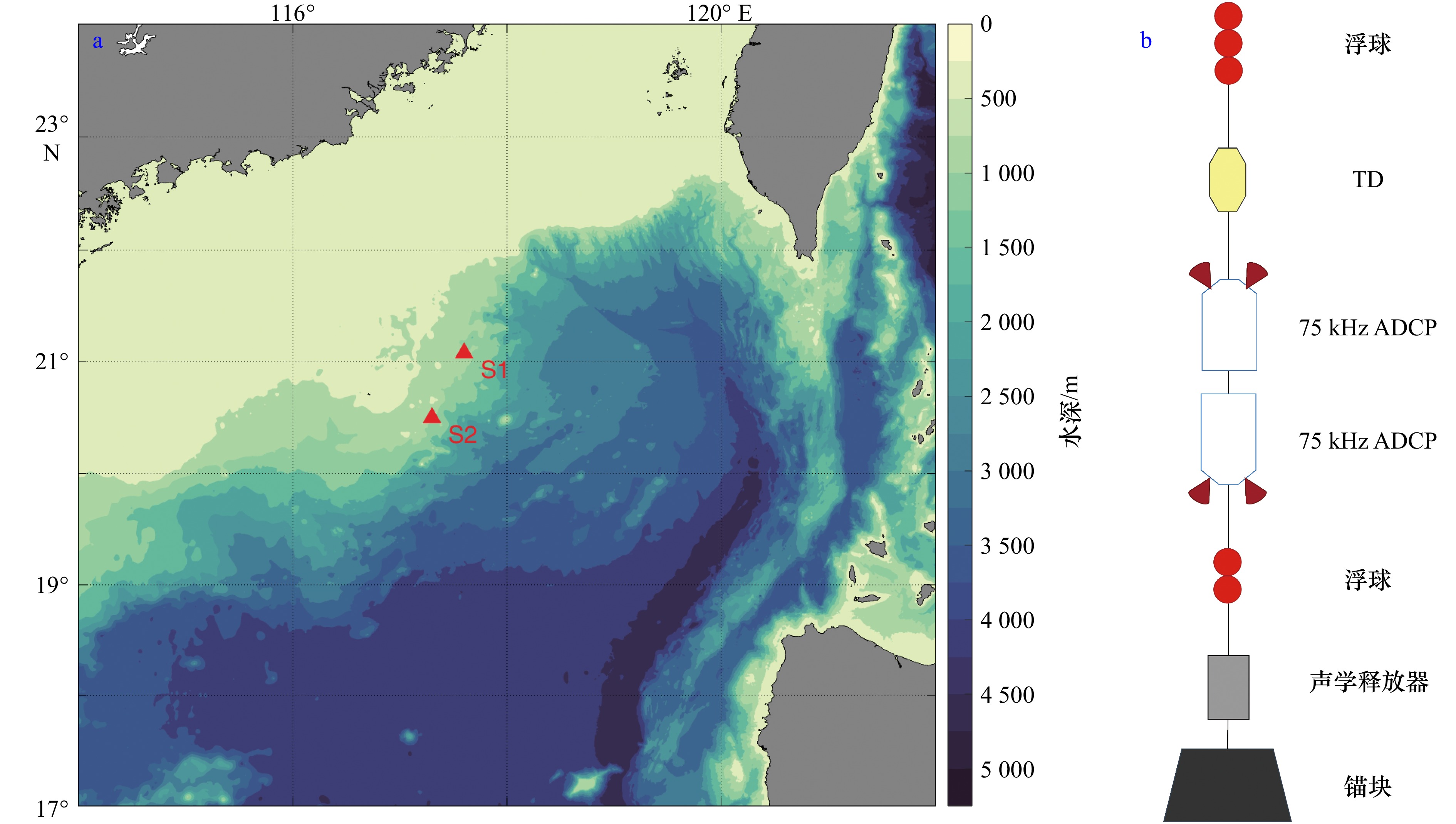
 下载:
下载:


